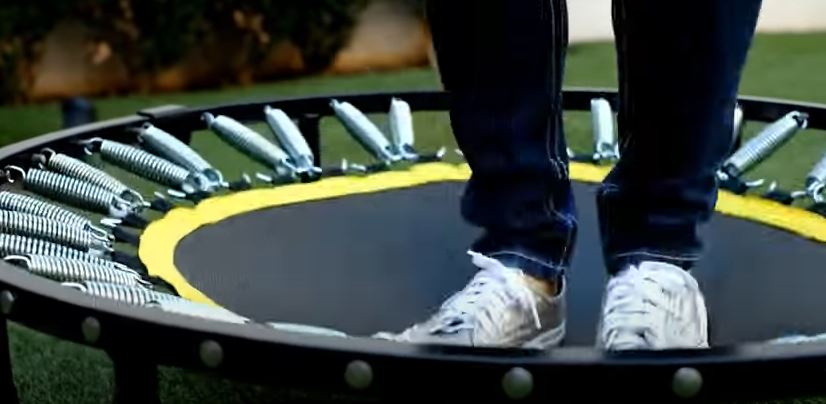Published on: October 6, 2022
Written by Ferris Jacob / Fact-checked by Samrul Alom
If you have a trampoline in your backyard, chances are you’ve also had to deal with the noise it can create. Trampolines can be quite loud, especially when multiple people are using them at the same time. There are a few things you can do to reduce the noise your trampoline makes.

- Trampolines are noisy when they are first set up;
- The best way to stop the noise is to let the trampoline settle for a few days;
- Once the trampoline has settled, you can start using it;
- Make sure to jump in the center of the trampoline and avoid jumping on the edges;
- If you must jump on the edges, make sure to use a soft landing mat or something similar to cushion your fall and reduce noise;
- Be careful not to drop anything on the trampoline as this will also create noise;
Brand New Trampoline Squeaking
If you’ve just purchased a new trampoline, you may be wondering why it’s making strange squeaking noises. Don’t worry, this is perfectly normal! The metal frame of the trampoline will expand and contract as the temperature changes, which can cause squeaking.
Additionally, the jumping mat and spring system will also settle into place over time, which may also contribute to squeaks. There’s no need to worry about your new trampoline making noise, it’s perfectly normal! However, if the noise is bothersome or continues after the trampoline has been in use for a while, you can try tightening any loose bolts or springs.
If that doesn’t help, you can contact the manufacturer for further assistance.
Trampoline Noise Complaints
If you live in a neighborhood with houses close together, chances are you’ve had to deal with noise complaints at some point. And if you’re the neighbor with the noisy trampoline, you may have gotten some angry looks or even a visit from the police. Trampolines can be a lot of fun, but they can also be quite loud.
The good news is that there are ways to reduce the noise your trampoline makes so that everyone can enjoy it without disturbance. Here are a few tips for reducing trampoline noise:
1. Use a Thick Mat
A thick mat will help to absorb some of the sounds your trampoline makes as people jump on it. This is especially helpful if your trampoline is located on a hard surface like concrete or asphalt.
2. Add Padding Around the Edge
Another way to reduce noise is to add padding around the edge of your trampoline. This will help to muffle any sounds made when people land on or bounce off of the edge of the trampoline.
3. Limit Use to Daytime Hours
If possible, try to limit the use of your trampoline to daytime hours when most people are not trying to sleep. This will help to avoid disturbing your neighbors and increase the likelihood that they’ll be okay with the occasional noise from your yard.
Best Lubricant for Trampoline Springs
If you have a trampoline, you know that one of the most important parts of owning one is keeping the springs lubricated. Without proper lubrication, your trampoline won’t be as bouncy and it could even break. So what’s the best lubricant for trampoline springs?
There are a few different types of lubricants that can be used on trampoline springs.
Silicone Spray
The most common type is silicone spray. This type of lubricant is easy to find and relatively inexpensive. It will also help to keep your springs from rusting.
WD-40
Another option is WD-40. This is a more heavy-duty option and can also be used to protect your springs from rusting. However, it can be a bit messy to apply and isn’t always as easy to find as silicone spray.
Baby Oil
Finally, there’s baby oil. This might seem like an odd choice, but it actually works really well as a trampoline spring lubricant!
It’s easy to apply and doesn’t leave behind any messy residue. Plus, it helps keep your springs looking shiny and new.
So there you have it – three great choices for trampoline spring lubrication!
No matter which one you choose, just make sure to reapply regularly (especially if you live in an area with high humidity) to keep your trampoline in tip-top shape!
Do Mini Trampolines Make Noise?

If you’ve ever wondered whether or not mini trampolines make noise, the answer is yes! Mini trampolines are designed to be lightweight and portable, so they can be used in a variety of settings, both indoors and outdoors. However, because they’re smaller in size, they can also be more likely to create noise when in use.
If you’re concerned about disturbing your neighbors or making too much noise indoors, there are a few things you can do to minimize the sound of your mini trampoline.
Springfree Trampoline Squeaking
If your Springfree Trampoline is squeaking, there are a few things you can do to try and fix the issue. First, check to see if any of the bolts or screws are loose. If they are, tighten them up with a wrench or screwdriver.
You may also want to lubricate the joints with WD-40 or another similar product. If the squeaking persists, it could be an indication that one of the springs needs to be replaced. You can purchase replacement springs from Springfree or from most hardware stores.
Once you have the new spring, simply remove the old one and replace it with the new one. Be sure to follow all safety instructions when performing this repair.
Squeaky Mini Trampoline
If you’re looking for a fun, challenging workout that’s easy on your joints, a mini trampoline may be just what you need. Not only is bouncing on a trampoline great exercise, but it’s also a lot of fun! There are many different types and sizes of mini trampolines available, so it’s important to choose one that’s right for you.
If you’re not sure where to start, this guide will help you choose the best mini trampoline for your needs. When shopping for a mini trampoline, pay attention to the size and weight limit. You want to make sure the trampoline is large enough for you to use comfortably, but not so large that it’s difficult to move around or store.
Also, check the weight limit to ensure the trampoline can support your weight. In terms of design, there are two main types of mini trampolines: spring-loaded and bungee-style. Spring-loaded trampolines have traditional metal springs that provide resistance when you bounce.
Bungee-style trampolines have elastic bands instead of springs, which offer a softer landing and are less likely to cause injuries if you fall off. Once you’ve decided on the type of mini trampoline you want, it’s time to consider accessories. Tramps (the padded mat placed over the springs or bungees) come in handy if you plan on doing any jumping exercises on your mini trampoline.
Handles can also be added for stability and safety while bouncing. Some models even come with built-in speakers so you can listen to music or audio books while working out!
WD-40 Specialist Heavy Duty Extreme Pressure Grease
WD-40 Specialist Heavy Duty Extreme Pressure Grease is a high-performance grease that provides long-lasting lubrication and protection against wear, rust, and moisture. This versatile grease can be used on a variety of surfaces, including metal, plastic, and rubber. It’s perfect for use in extreme conditions, such as high temperatures and wet environments.

How Can I Make My Rebounder Quieter?
If you’re looking for ways to make your rebounder quieter, there are a few things you can try.
| No. | Things to try | Details |
| 1 | Rebounder has adjustable legs | If it does, try adjusting the legs so that the rebounder is closer to the ground. This will help reduce the amount of noise the rebounder makes as it bounces. |
| 2 | Try to place a mat under the rebounder | This will help muffle the sound of the bouncing ball and make it less noticeable. |
| 3 | Consider investing in a silent or low-noise rebounder | These types of rebounders are designed to be much quieter than traditional ones and can be a great option if you’re looking for a way to reduce noise levels. |
Should I Oil Trampoline Springs?
When it comes to trampoline springs, there are a few things you should keep in mind. First of all, oiling your springs is not necessary and can actually do more harm than good. Secondly, if you do choose to oil your springs, be sure to use a light lubricant such as WD-40 or 3-in-1 oil.
Thirdly, always wipe away any excess oil after applying it to the springs.Now that we’ve got that out of the way, let’s talk about why you shouldn’t oil your trampoline springs. Oiling them can cause the metal to break down and become weaker over time.
It can also attract dirt and dust, which will eventually lead to corrosion. And finally, it makes the spring less bouncy, which kind of defeats the purpose of having a trampoline in the first place!So there you have it – reasons why you shouldn’t oil your trampoline springs.
Of course, ultimately the decision is up to you but we would recommend against it!
How Do You Stop Squeaky Springs?

If your sofa has squeaky springs, there are a few things you can do to try to fix the issue. First, check to see if the springs are loose by pressing down on the couch cushions. If they give easily, then the springs may need to be tightened.
You can do this by twisting them with pliers or a screwdriver.If the springs are not loose, then the issue could be that they’re old and worn out. In this case, you’ll need to replace them with new ones.
To do this, simply remove the old springs and install new ones in their place. Be sure to measure the length and width of the old springs so you get ones that fit properly. Finally, use pliers or a screwdriver to twist them into place.
How Often Should You Replace Trampoline Springs?
Trampoline springs are one of the most important parts of your trampoline, and they need to be replaced regularly in order to keep your trampoline safe and functioning properly. Depending on how often you use your trampoline, as well as the weight and height of the users, you may need to replace your springs anywhere from every few months to every few years. If you notice that your trampoline isn’t bouncing as high as it used to, or if there are any visible signs of wear and tear on the springs, then it’s definitely time for a replacement.
corroded or damaged springs can cause serious injury, so it’s always better to be safe than sorry. When replacing trampoline springs, make sure to get the right size and type of spring for your particular model of trampoline. It’s also a good idea to replace all of the springs at once rather than just one or two at a time – this will help ensure that all of the springs are evenly matched and will provide optimal performance.
Conclusion
If you have a trampoline in your backyard, chances are you’ve also had to deal with the noise it can create. There are a few things you can do to help reduce the amount of noise your trampoline makes. One is to make sure that the mat is properly stretched.
This will help to absorb some of the sounds. Another option is to add a layer of padding underneath the mat. This will help to deaden the sound even further.
Finally, you can try placing your trampoline on grass instead of concrete or asphalt. This will help to reduce the amount of vibration and thus noise as well.
References: